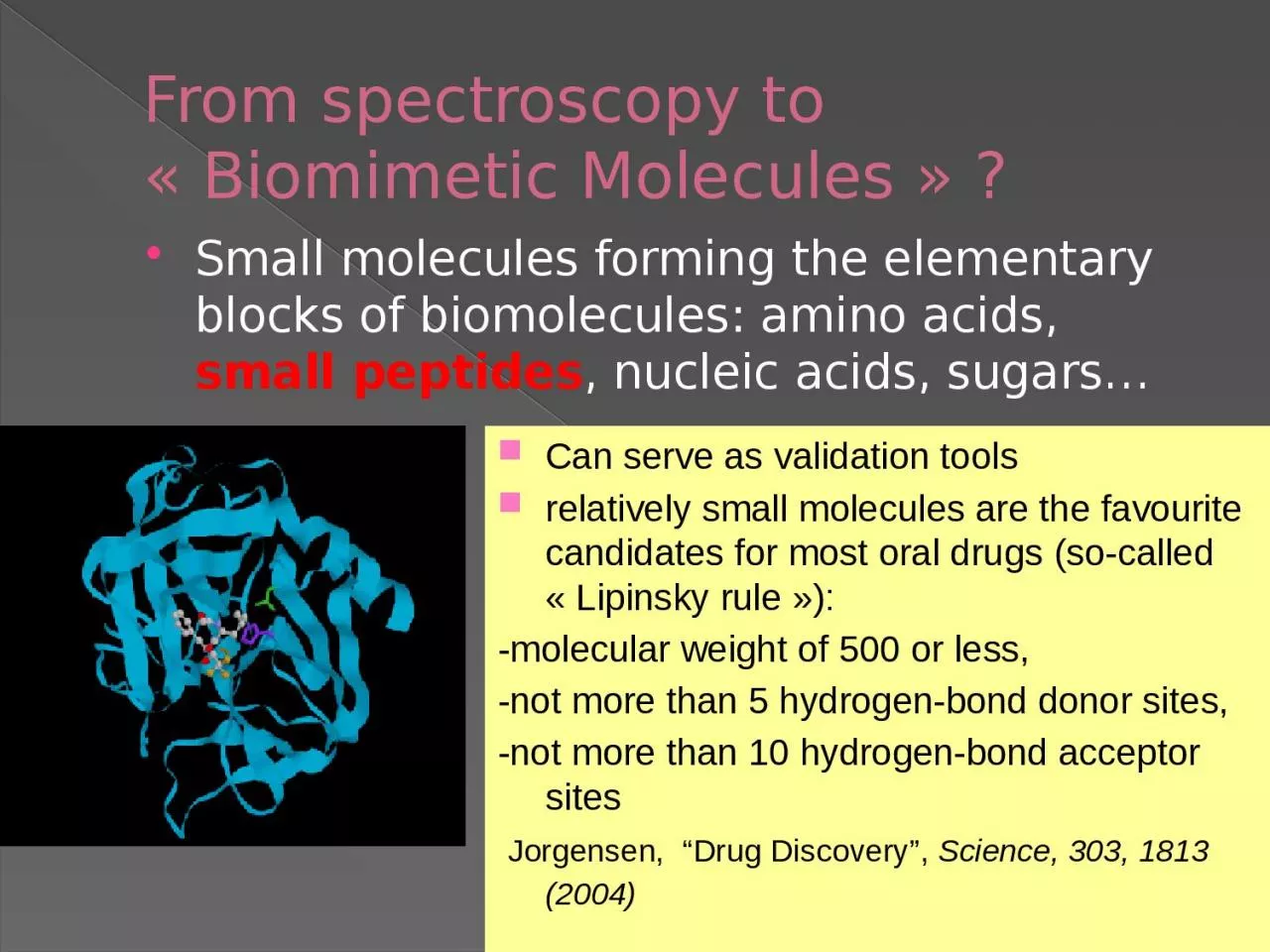

Small molecules forming the elementary blocks of biomolecules amino acids small peptides nucleic acids sugars Can serve as validation tools relatively small molecules are the favourite candidates for most oral drugs ID: 931885
Download Presentation The PPT/PDF document "From spectroscopy to « Biomimetic Mole..." is the property of its rightful owner. Permission is granted to download and print the materials on this web site for personal, non-commercial use only, and to display it on your personal computer provided you do not modify the materials and that you retain all copyright notices contained in the materials. By downloading content from our website, you accept the terms of this agreement.
Slide1
From spectroscopy to « Biomimetic Molecules » ?
Small molecules forming the elementary blocks of biomolecules: amino acids, small peptides, nucleic acids, sugars…
Can serve as validation
tools
relatively small molecules are the favourite candidates for most oral drugs
(
so
-
called
«
Lipinsky
rule
»):
-
molecular weight of 500 or less,
-not more than 5 hydrogen-bond donor sites,
-not more than 10 hydrogen-bond acceptor sites
Jorgensen, “
Drug Discovery”,
Science, 303, 1813 (2004)
Slide2.
« Effectifs Hamiltonians »opérateurs x paramètres :
Development in series
« Quantum chemistry »,
ab initio
Eq. Schrödinger (Born-Oppenheimer)
Interatomic distances, angles
Spectra analysisLine positions and intensity fit
Spectroscopic parameters related to molecular structure : rotation constants, Torsion potential function, electric dipole moments, vibrational parameters …
Gas phase studies
NMR, X-ray, Raman,
IR condensed phase
Studies
Force field calculations
Biological processes in situ
Slide3What
systems ?Proteins are formed by a reservoir of 20 amino acids. Amino acids are related by peptidic bondings to form polypeptides
Peptide link: rigid, planar
Residue 1
Residue 2
Residue3
Formation of peptide link by
condensation and elimination of
water
Only certain values of the Ramachadran angles
f
and
Y
are possible
Backbone
chain
Side chain
Slide4b
sheets
a
helix
Primary structure Secondary Tertiary Quaternary
Hydrogen Bond
g
turns
Slide5Hydrogen Bond & Torsion
Secondary and tertiary structure of proteins How is Microwave spectroscopy at high resolution going to contribute ???
: Internal rotation splittings can be used to obtain the structure/folding of molecules in gas phase WITHOUT doing isotopic substitution
.
Lavrich et al. JCP 2003
Slide6Dipeptide Mimetic: collaboration with NIST
Alanine Dipeptide :
N-Acetyl Alanine Methyl
Amide
(
AAMA)
N-
Acetyl
Alanine Methyl Ester Molecule (AAME)
Ethyl Acetamidoacetate: EAA
JB95+BELGI ,2 lowest conformers
Lavrich et al, JCP 2003 V3(1)= 70 cm
-1
JB95, Lavrich et al. JCP 2003V3(1)=98 cm-1, V3(2)=81 cm-1
Decomposition product
JB95+BELGI: JCP 2006
V
3(1)=68 cm-1, V3
(2)=407 cm-1
JB95V3(1)=322 cm
-1
Slide7The Microwave Spectrum of a Two-top Peptide Mimetic:
N-Acetyl Alanine Methyl Ester Molecule (AAME), Plusquellic, Kleiner J. Chem. Phys. 125, 104312 (2006)
123 lines fitted
RMS= 2.5 kHz
17 parameters
V
3
= 64.96(4) cm
-1
130 lines fittedRMS= 1.8 kHz14 parametersV3
= 396.45(7)cm-1
Slide8Conformational searches, Structure and hydrogen bond
13 stable conformers of ADME located, full geometry optimisations with B3LYP/6-31G(d) et G3MP2B3Comparison of ab initio structure for AAMA (alanine dipeptide) et ADME (N-acetyl alanine methyl ester)
AAMA
ADME
C
5
C
7
ψ
Ramachandran angles
Ψ
171°
φ
-159°Similar to a b-sheet structure
φ
Ramachandran angles Ψ
75° φ -82°
Similar to a g-turn structure
Slide9Internal rotation and structure of esters
Collaboration
with
Institute of Physical Chemistry, RWTH Aachen (Germany):
W. Stahl, L. Nguyen, H.
Mouhib
, T. Attig
, Y. Zhao, D. Jelisavac, L. Sutikdja
, R. Kannengisser
Esters (or cetones) of large size not much
studied by microwave spectroscopy
- Too many atoms to
determine their structure by isotopic substitution
- Large internal rotation splittings, serve as test of our models-
Determination of the structure of the most stable(s) conformer(s)
Ethyl
acetate
100 cm
-1
1000 cm
-1
Allyl
acetate
100 cm
-1
Isoamyl
acetate
Methyl
propionate
Mol. Phys 2012
Mol. Phys 2012
JMS 2012
Methyl
Neopentyl
ketone
Mol Phys 2010
JMS 2009
Methyl
acetate
JMS 2011
Slide10Conformational
analysis of n
-pentyl acetate
using
microwave
spectroscopyJ. Mol. Spectrosc
., 290,
2013, 24-30T.
Attig, R. Kannengießer, I.
Kleiner, W. Stahl
The
microwave
spectrum of n-butyl acetate
J. Mol. Spectrosc. 284–285, 2013
, 8-15T.
Attig, L.W. Sutikdja, R.
Kannengießer, I. Kleiner
, W. Stahl
Structural studies on banana oil,
isoamyl
acetate,by means of microwave spectroscopy and quantumchemical
calculations
L.W. Sutikdja, D. Jelisavac
, W. Stahl and I. Kleiner
Mol. Phys 110, 2883–2893 (2012)
Slide11Nguyen,
Kleiner
et al
Phys.Chem
. Chem.
Phys.,
15
, 10012 (2013)